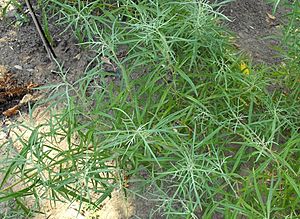San Diego sagewort facts for kids
Quick facts for kids San Diego sagewort |
|
|---|---|
 |
|
| Scientific classification | |
| Genus: |
Artemisia
|
| Species: |
palmeri
|
| Synonyms | |
|
|
Artemisia palmeri is a special and somewhat rare plant. It's a type of sagebrush. People often call it San Diego sagewort or Palmer sagewort.
Contents
Where This Plant Lives
This plant naturally grows in a few specific places. You can find it in northwestern Baja California (which is in Mexico) and in southwestern California in the United States. It's mostly found in an area called San Diego County.
Its Favorite Homes
Artemisia palmeri loves sandy areas near the coast. It grows in places called coastal sage scrub communities. It also likes riverbeds near water, known as riparian areas. These spots are usually in mountains like the Cuyamaca Mountains. It grows at elevations below 600 meters (about 2,000 feet).
Sadly, many of these natural homes have been changed or built on by people. This means there's less space for the plant to grow. Sometimes, you might find it a bit further inland in chaparral areas. These are near places like Redlands.
Why It's Special
Because its natural home is disappearing, Artemisia palmeri is listed as an endangered species. This means it's a plant that needs protection so it doesn't vanish completely. The California Native Plant Society keeps track of rare plants like this one.
What Artemisia palmeri Looks Like
Artemisia palmeri can be a perennial or biennial plant. This means it can live for more than two years, or sometimes just two years. It grows stems that are usually straight up or spread out. These stems can be quite tall, from 1 to 3 meters (about 3 to 10 feet) high. The bottom part of the plant is woody.
Leaves and Smell
The leaves of this plant are a gray-green color. They have a nice, strong smell. The leaves are long and narrow. They are also deeply cut into several thin, pointed parts.
Flowers and Seeds
The plant produces groups of small flower heads. These flower heads contain tiny, pale yellow disc florets. These small flowers have glands, which means they might feel a bit sticky. Artemisia palmeri usually blooms from June all the way to October.
After the flowers, the plant makes tiny fruits called achenes. These are very small, only about a millimeter long.
See also
 In Spanish: Artemisia palmeri para niños
In Spanish: Artemisia palmeri para niños

